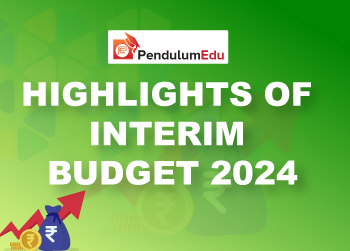Topic: Indian Economy/Financial Market
1. India's core sector growth dropped to 0.5% in April 2025.
- This is the lowest level in eight months. It marks a sharp decline from 4.6% recorded in March.
- In April 2024, core sector growth was significantly higher at 6.9%.
- Crude oil output fell by 2.8% in April. This follows a 1.9% decline in March.
- Refinery output contracted by 4.5% in April. In contrast, it had seen a small increase of 0.2% in March.
- Fertiliser production dropped by 4.2% in April. This is a sharp fall from 8.8% growth in March.
- Coal production rose by 3.5% in April. This is an improvement over the 1.6% growth recorded in March.
- Natural gas output increased slightly by 0.4% in April. This comes after a major 12.7% contraction in March.
- Steel production grew by 3% in April. However, it slowed down from 9.3% growth in March.
- Cement output increased by 6.7% in April. This is lower than the 12.2% growth seen in March.
- Electricity generation was up by 1.0% in April. This is a drop from 7.5% growth in March.
- The core sector includes coal, crude oil, natural gas, refinery products, fertilisers, steel, cement, and electricity.
- These eight industries make up over 40% of the Index of Industrial Production (IIP).
Topic: Corporates/Companies
2. Corporate insolvency cases under the Insolvency and Bankruptcy Code (IBC) have declined sharply.
- These dropped from 1,262 in FY23 to 723 in FY25.
- The average time to complete a Corporate Insolvency Resolution Process (CIRP) has increased.
- It rose from 614 days in FY23 to 717 days in FY25.
- The approval time for resolution plans has also grown significantly.
- It increased from 611 days in FY23 to nearly 850 days in FY25.
- These durations are far longer than the 330-day limit set by the IBC.
- This limit includes extensions and time spent in litigation.
- Creditors continue to recover only a small portion of their claims.
- Recoveries have remained between 31 and 32 per cent.
- In FY25, creditors recovered 32.8 per cent. This compares to 32.1 per cent in FY24 and 31.8 per cent in FY23.
- Fewer insolvency professionals are joining the system. Registrations fell from 549 in FY22 to 110 in FY25.
- A resolution plan aims to restore the business as a going concern.
- This can involve restructuring, mergers, or other forms of corporate reorganisation.
- Corporate Insolvency Resolution Process (CIRP):
- CIRP can be initiated by financial creditors, operational creditors, or the corporate debtor.
- It is a legal process under the IBC to resolve corporate insolvency.
Topic: Regulatory Bodies/Financial Institutions
3. Insurance Regulatory and Development Authority of India (IRDAI) has imposed a fine of ₹1 crore on Acko General Insurance.
- The penalty was imposed for not following rules related to outsourcing activities.
- It was also due to violations in the payment of commissions and rewards to agents and intermediaries.
- IRDAI has instructed Acko to present this order at its next board meeting.
- The insurer must provide IRDAI with a copy of the board meeting minutes.
- Acko is also required to submit an action taken report.
- This report must be sent within 90 days from the date of the order.
- Acko General Insurance is a private sector general insurance company in India.
- Insurance Regulatory and Development Authority of India:
- IRDAI was constituted as the Insurance Regulatory and Development Authority (IRDA) in 1999 after the recommendations of the Malhotra Committee report. IRDA was later renamed IRDAI.
- It was constituted as an autonomous body to regulate and develop the insurance industry.
- It was incorporated as a statutory body on April 19, 2000.
- Debasish Panda is the Chairperson of IRDAI. It is headquartered in Hyderabad.
- It is an autonomous and statutory body under the jurisdiction of Ministry of Finance.


Topic: Banking/Financial/Govt Schemes
4. Union Minister Pralhad Joshi launched three new digital platforms—Depot Darpan, Anna Mitra, and Anna Sahayata.
- These are designed to modernize and strengthen India’s Public Distribution System (PDS).
- The goal is to boost transparency, improve infrastructure, and support both workers and beneficiaries involved in food grain distribution.
- India’s PDS currently serves over 81 crore people.
- It operates through a vast network of more than 5.38 lakh Fair Price Shops.
- Depot Darpan is a digital monitoring platform for food grain depots.
- It allows self-assessment and helps improve operational and infrastructure standards.
- It uses advanced technologies such as IoT sensors and CCTV for real-time monitoring and analytics.
- The system is expected to save ₹275 crore in FCI depots.
- It could also generate ₹140 crore in extra income in CWC warehouses through better use of space.
- Anna Mitra is a digital tool for key PDS stakeholders. It provides stock tracking, sales reports, alerts, and grievance handling features.
- FPS dealers, DFSO officers, and food inspectors each have tailored features on the platform.
- These include geo-tagged inspections and FPS performance ratings.
- Anna Sahayata is a citizen-friendly grievance redressal system. It supports over 81 crore PDS beneficiaries.
- The platform uses WhatsApp, IVRS, and automatic speech recognition to make filing complaints simple and accessible.
- Anna Mitra is currently available in Assam, Uttarakhand, Tripura, and Punjab. It supports Hindi and English.
- Anna Sahayata is in the pilot phase in Gujarat, Jharkhand, Telangana, Tripura, and Uttar Pradesh.
- It supports five languages—Hindi, Gujarati, Telugu, Bangla, and English.
- Both platforms will be expanded across all states and union territories. They will be integrated with state-level systems for nationwide coverage.
Topic: Summits/Conferences/Meetings
5. India assumed the chairmanship of the Asian Productivity Organization at the 67th Governing Body Meeting in Jakarta.
- India officially took over the chairmanship of the Asian Productivity Organization (APO) for 2025–26 during the ongoing 67th Session of the Governing Body Meeting (GBM) of the APO.
- The Governing Body Meeting was held from 20–22 May 2025 in Jakarta, Indonesia.
- Shri Amardeep Singh Bhatia, Secretary of DPIIT and APO Director for India, led the Indian delegation.
- India reaffirmed its commitment to advancing APO Vision 2030 and expanding the Green Productivity 2.0 framework.
- The focus was placed on promoting regional cooperation to boost innovation, sustainability, digital transformation, and entrepreneurship.
- India expressed its intention to contribute to inclusive and effective APO programs addressing productivity challenges in Asia-Pacific.
- More than 100 Indian professionals participate annually in APO capacity-building programs through the National Productivity Council.
- These programs contribute significantly to improving productivity in India's industrial, service, and agricultural sectors.
- Several demonstration projects focused on green productivity and Industry 4.0 applications for MSMEs have also been implemented across the country.
- The Governing Body, APO’s top decision-making authority, meets annually to decide strategic directions and review performance.
- The APO, established in 1961, includes 21 member economies, with India being a founding member and a key contributor to its initiatives.
Topic: Miscellaneous
6. The Department of Telecommunications has launched the Financial Fraud Risk Indicator (FRI).
- This tool is designed to help prevent cyber-related financial crimes.
- FRI enables real-time intelligence sharing with banks, UPI providers, and financial institutions.
- It strengthens payment security by flagging suspicious mobile numbers before transactions take place.
- The system allows for quick, coordinated responses across telecom and financial sectors.
- FRI was developed under the Digital Intelligence Platform (DIP).
- It assigns mobile numbers a fraud risk rating: Medium, High, or Very High.
- These ratings are based on reports from Indian Cybercrime Coordination Centre National Cybercrime Reporting Portal, DoT’s Chakshu platform, and financial institutions.
- DoT’s Digital Intelligence Unit also shares a Mobile Number Revocation List.
- This list includes numbers deactivated for reasons like cybercrime, verification failure, or misuse.
- Since fraud numbers are typically used for only a few days, early warnings are critical.
- Once a mobile number is reported, it goes through a multi-layer analysis.
- The resulting risk level is then quickly shared with all relevant stakeholders.
- PhonePe was among the first to adopt FRI.
- It blocks transactions involving Very High risk numbers and alerts users through its "PhonePe Protect" feature.
- PhonePe's data shows that FRI is highly accurate in identifying fraud-prone numbers.
- Other UPI platforms like Paytm and Google Pay are also integrating FRI.
- Together, these platforms handle over 90% of UPI payments in India.
- Several banks are also using FRI data to detect and stop cyber fraud.
- The tool is expected to become a standard across the financial sector.
- By using FRI, millions of users could be protected from digital fraud.
- FRI is a step toward building a safer, more resilient digital financial ecosystem in India.
Topic: Indian Economy/Financial Market
7. India’s GDP is expected to grow between 6.4% and 6.5% in Q4 of FY25.
- This projection comes from a recent report by the State Bank of India (SBI).
- The Indian economy has remained strong despite global economic challenges.
- SBI’s Economic Research Department used a Nowcasting Model to estimate growth.
- This model includes 36 high-frequency indicators.
- The indicators cover industrial output, service sector performance, and global trends.
- The model is based on a dynamic factor method. It draws on data from Q4 FY13 to Q2 FY23.
- The India Meteorological Department (IMD) expects the monsoon to arrive early in Kerala. It could arrive within four to five days.
- This would be the earliest mainland monsoon since May 23, 2009.
- Favorable rainfall is likely to support agriculture.
- India has set a foodgrain production target of 354.64 million tonnes for 2025–26.
- The 2024–25 target was 341.55 million tonnes.
- So far, 332.3 million tonnes have been produced this year.
- Household surveys show that inflation expectations are easing.
- This is encouraging consumers to spend more on non-essential items.
- Increased discretionary spending is driving demand-led growth.
- However, consumer confidence remains steady.
- This suggests that households remain cautious about global economic conditions.
- Ongoing global trade tensions are a concern. There is also a high degree of policy uncertainty worldwide.
- These factors are expected to slow global economic activity.
- The International Monetary Fund (IMF) projects global growth at 2.8% in 2025. It is expected to be 3% in 2026. India’s economy is more stable in comparison.
Topic: Banking System
8. India Post Payments Bank and Aditya Birla Capital joined hands to expand credit access across the country.
- A strategic partnership has been established between India Post Payments Bank (IPPB) and Aditya Birla Capital Limited (ABCL) to enhance the reach of loan products across India.
- Through this collaboration, IPPB will act as a referral partner offering ABCL's financial solutions like personal loans, business loans, and loans against property.
- Customers of IPPB will now be able to access loan services digitally via Aditya Birla Capital's tech-enabled platforms, ensuring quick approvals and minimal documentation.
- Advanced AI and data analytics have been integrated into the lending process to provide customized financial solutions for a broad spectrum of customers.
- The loan application process has been designed to be hassle-free, in alignment with the goal of improving financial accessibility across rural and urban India.
- IPPB will refer customers to ABCL on a non-risk participation basis, with final credit decisions to be made solely by ABCL.
- This partnership supports the vision of Digital India and aims to empower every citizen financially by bridging the gap between rural customers and mainstream credit services.
- India Post Payments Bank (IPPB):
- IPPB has been established under the Department of Posts, Ministry of Communications, with 100 percent equity owned by the Government of India.
- IPPB was launched on September 1, 2018.
- IPPB aims to serve the unbanked and underbanked by leveraging its vast postal network of 1.65 lakh post offices and 3 lakh employees, especially in rural areas.
- IPPB provides simple and affordable banking solutions to 11 crore customers across 5.57 lakh villages and towns in India through an intuitive interface available in 13 languages.


 Previous
Previous 
 Latest
Latest 








Comments